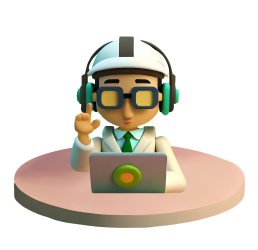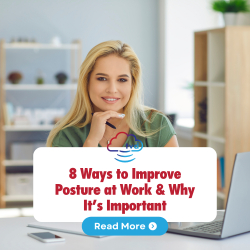Less than 20% of the job force is made up of physically active jobs. If you are a part of the other whopping 80%, you may be facing health issues due to bad posture and lack of movement that comes with desk jobs and their lack of activity. The work force has dramatically shifted to more sedentary jobs, which have now increased by 83% since 1950 as reported by the American Heart Association.
How Bad Posture Affects Your Health
Dr. Alasha Young of Young Life Chiropractic shared how bad posture leads to a myriad of health problems, and that sitting in general puts up to 90% more pressure on your lower back than when you are standing. “This can result in pain in your low back, but also puts you at risk for much bigger problems down the road if the area isn’t stabilized.” This is why it is more important than ever to refine work habits to improve posture.
Luckily, there are several tips that you can utilize to improve posture for improved overall health.
8 Tips to Improve Posture
- Keep Your Computer at Eye Level
As the use of laptops increases, your correct posture decreases. Your computer should be directly in front of you with the screen at eye level. A good rule of thumb is to have the monitor placed at about an arm’s length away, with the top of the screen roughly at eye level.
As much as we all love our laptops, they may not be the best choice for overall health. “As your head comes forward,” explains Dr. Alicia Young, “you are adding pound of force to your cervical spine and disfunction in the nervous system.”Switching to a monitor with a separate keyboard is ideal, but sometimes not always doable. If you still prefer using a laptop to keep your work on the go, make sure it is propped up on your desk or table rather than on your lap. If possible, connect to an external monitor that sits at eye level to continue using your laptop but with a more ergonomically suited height.
2. Default to a Chair with Lumbar Support
Your chair could be the thing keeping you from a pain-free day at work. Be sure your chair follows the natural contour of your spine. As much as we all love a nice, fancy leather chair, switching to one with lumbar support and breathable material is ideal.
Things to look for in a good chair include lower back support, a chair back that follows the natural “S” curve of the spine, an adjustable back, adjustable height, a neck rest when possible, and preferably one that swivels to reduce twisting and jerking motions.
3. Have Your Keyboard at a Comfortable Distance
In addition to your computer monitor, you keyboard position also play a crucial role in your posture. Make sure your keyboard is directly in front of you at a comfortable distance that allows enough room to rest your wrists on the desk. Be sure to keep your arms at an L shape by your sides.
If you need extra support, you can improve typing posture by utilizing a wrist rest on your desk or arm rests on your office chair. This helps ensure your wrists and forearms are at the same heigh as your keyboard.
4. Keep All Necessary Objects at an Arms Length
Be sure to keep all frequently used objects in a close vicinity so that you never need to over reach or twist your body to grab them. Your phone, mouse, writing utensils, and other necessary equipment should be no more than an arms length away ensuring that you don’t have to break your good posture.
5. Swap your Phone’s Handset for a Headset
The way you use your desk or cell phone can have a significant impact on your posture. Cradling your handset or cellphone between your shoulder and neck can put strain on your neck and shoulder muscles leading to neck pain and headaches. Swapping to a comfortable headset can greatly improve posture and spine health.
If you utilize any of the Travis hosted phones, you can utilize our headsets which are specifically designed for our hosted phone line and come in a range of styles from in-ear to over the head with both one and two ear pad options. This allows for hands free calling in a comfortable style.
6. Take Breaks and Stretch
Be sure to change your position and stretch your legs. Even if its a quick trip to fill up your water bottle, a quick break every hour allows you to continuously relieve strain on your back from sitting. Shorter, more frequent breaks have have been proven to be more beneficial than longer, and less frequent ones.
Dr. Alicia recommends standing up at least every 30 minutes. During these breaks, she mentions to be sure to stretch, especially in the areas that often cause you strain. “When seated for a long time, our hip flexors tend to get very tight and shorten, our glute muscles deactivate, our low back tends to get weak and unstable and we become more prone to a slouched position.” If possible, utilize a standing desk every so often to give your muscles a chance to relax.
7. Above All Else, Sit Up Straight!
We know this is the last thing you were hoping to hear because it seems like this is something you would already know, but going back to the basics is sometimes all it takes. Yes, fancy equipment designed to improve posture can be good, but the simple tricks are really all it takes to start feeling relief soon. Its important to always remember:
- Keep your shoulders back
- Don’t look down too much
- Keep both feet flat on the floor
- Make sure your sine is in an “S” curve
- Don’t lean too far forward
- Don’t hold tension in your body
8. Still in Pain? See a Professional
Sometimes we need extra support that only a trained professional can provide. You aren’t going to brush your teeth only when they hurt, so you shouldn’t treat your spine the same way. Regular adjustments from a chiropractor can significantly reduce strain on your muscles and joints. Dr. Alicia Young is one of the many chiropractic professionals that has helped professionals relieve pain caused by bad posture at work. “Chiropractic care corrects misalignments in your spine, helps restore natural spinal curves, can prevent early spinal degeneration, calms your nervous system and improves your overall health and wellness. This simple combo will make a world of difference when it comes to the proper stabilization of your spine and encouraging healthy musculoskeletal biomechanics.”
We know bad habits can be hard to break, but just remember its much easier to break bad habits than it is to deal with a broken back.






